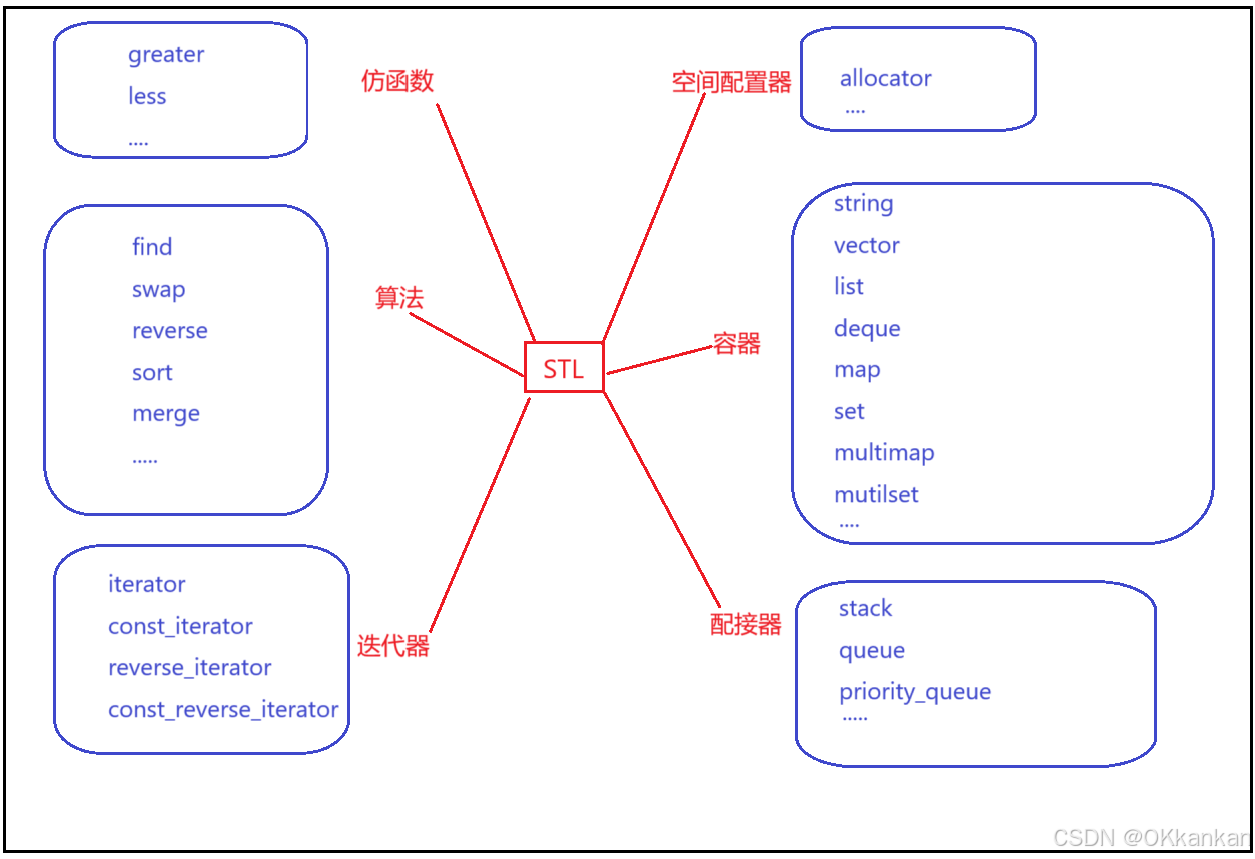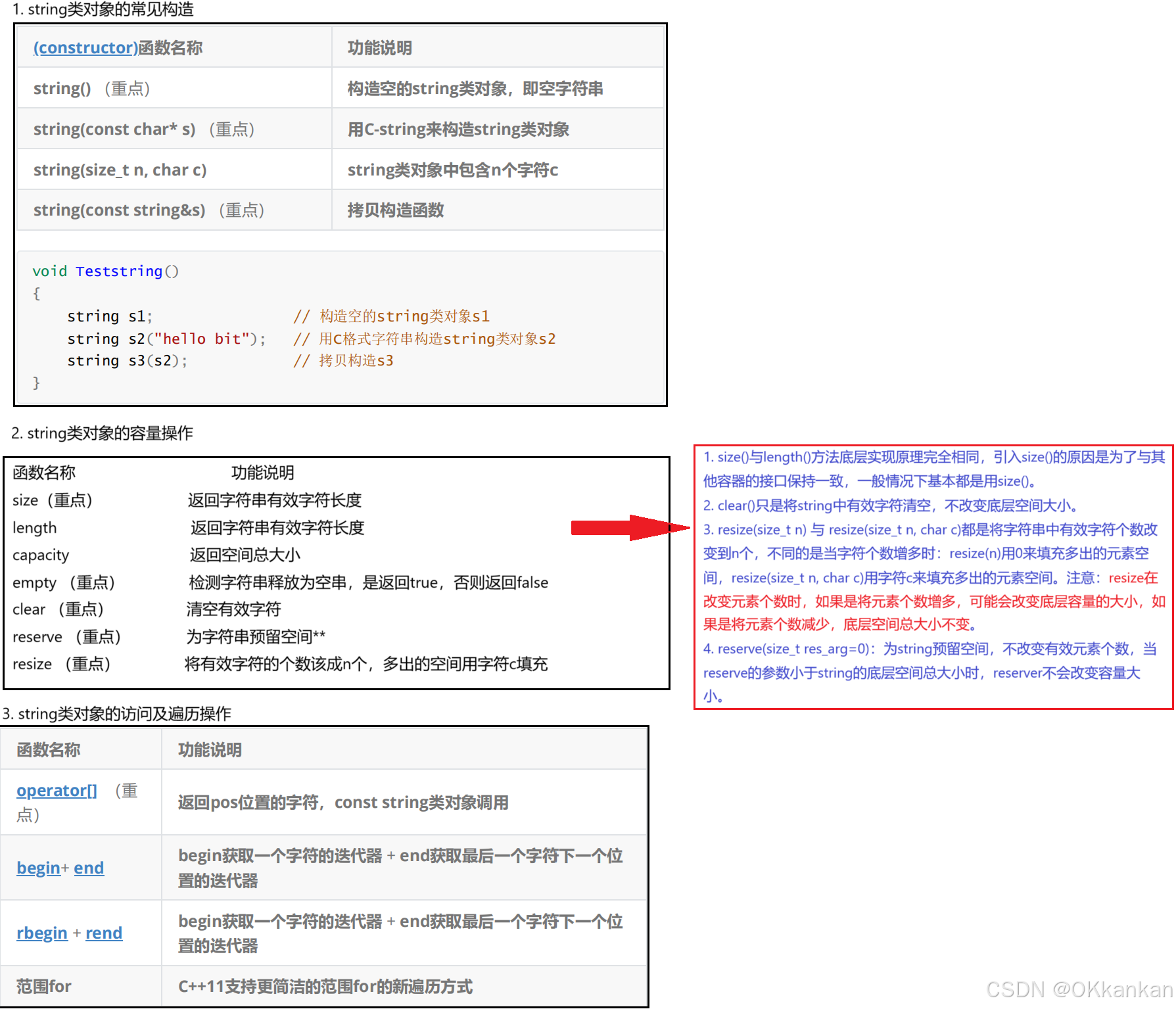一. STL
STL(Standard Template Library,标准模板库)是 C++ 编程语言的一个重要组成部分,主要用于提供通用的数据结构和算法,以提高代码的复用性和开发效率。而且是一个包罗数据结构与算法的软件框架。
上面是STL的六大组件,STL为C++提供了大量的数据结构算法以及众多的库函数,在实现很多程序的时候提供了非常便捷的方法,提高了开发效率并且保证了代码的质量,也增强了代码的可读性,今天我们主要来认识一下STL中非常重要的一部分string类,string类主要是管理字符串的,为什么要学习string呢?在C语言中当我们要实现字符串的增删查减时其实是比较复杂的,我们需要自己开辟空间以及调用大量的库函数来帮助我们实现,但是在学习了string类之后你就会发现很多关于字符串的算法会变的方便很多。
二. 标准库中的string类
2.1 string类的初步了解及使用
在使用string类的时候必须包含#include头文件以及using namespace std;
在string类中包含了大量的库函数以及算法,我们要学会使用一些文档来帮助我们记忆学习,比如在C++刚开始学习的时候我推荐大家使用的一个网站,就是可以查询C++库函数的使用方法以及它所包含的结构算法,我把链接放在这里:https://legacy.cplusplus.com/reference/。
下面就是string一些基本的用法,我们要先学会使用一些基本的语法,后面再一步步数量掌握:
cpp
#include<iostream>
using namespace std;
//字符串的初始化
int main()
{
string s1;
string s2 = "hello world";
string s3(s2);
//指定字符重复多次初始化
string s4(5, 'a');
cout << s1 << endl;
cout << s2 << endl;
cout << s3 << endl;
cout << s4 << endl;
return 0;
}
cpp
//字符串的拼接、删除、查找、替换等
int main()
{
string s1 = "hello ";
string s2 = "world";
//使用 + 拼接
string s3 = s1 + s2;
//使用append拼接
s1.append(s2);
cout << s3 << endl;
cout << s1 << endl;
//查找字符串
string s4 = "hello China";
size_t pos = s4.find("China");
if (pos != string::npos)
{
cout << "Found 'China' at position: " << pos << endl;
}
else
{
cout << "Did not find 'China'" <<endl;
}
//替换字符串
string s5 = "Hello World";
size_t pos1 = s5.find("World");
if (pos1 !=string::npos)
{
// 替换子字符串
s5.replace(pos1, 5, "Universe");
}
cout << "Replaced string: " << s5 << endl;
//遍历字符串
string s6 = "Hello";
// 使用范围 for 循环遍历
for (char c : s6) //这里相当于把s6依次赋给c
{
cout << c << " ";
}
cout << endl;
// 使用迭代器遍历
for (string::iterator it = s6.begin(); it != s6.end(); ++it)
{
cout << *it << " ";
}
cout << endl;
//字符串长度
string s7 = "zheng";
// 获取字符串长度
size_t length = s7.length();//这里使用size也可以
cout << "Length of str: " << length << endl;
return 0;
} 上面就是string类中的一些基本的使用,我们先要掌握好这些基础的使用才会在后面的学习更加如鱼得水,当然这只是string中的一小部分,我们要学会去查看文档得到我们需要的函数。
上面就是string类中的一些基本的使用,我们先要掌握好这些基础的使用才会在后面的学习更加如鱼得水,当然这只是string中的一小部分,我们要学会去查看文档得到我们需要的函数。
2.2 auto和范围for
auto:
1.在早期C/C++ 中 auto 的含义是:使用 auto修饰的变量,是具有自动存储器的局部变量,后来这个 不重要了。C++11中,标准委员会变废为宝赋予了auto全新的含义即: auto不再是一个存储类型指示符,而是作为一个新的类型指示符来指示编译器,auto声明的变量必须由编译器在编译时期推导而得 。
2.用auto声明指针类型时,用auto和auto*没有任何区别, 但用auto声明引用类型时则必须加& ,当在同一行声明多个变量时,这些变量必须是相同的类型,否则编译器将会报错,因为编译器实际只对第一个类型进行推导,然后用推导出来的类型定义其他变量。
3. auto不能作为函数的参数,可以做返回值,但是建议谨慎使用 。
4. auto不能直接用来声明数组。
cpp
#include<iostream>
using namespace std;
int func1()
{
return 10;
}
// 不能做参数
//void func2(auto a)
//{}
// 可以做返回值,但是建议谨慎使用
auto func3()
{
return 3;
}
int main()
{
int a = 10;
auto b = a;//b的类型就和a的类型一样,int
auto c = 'a';
auto d = func1();
// 编译报错:rror C3531: "e": 类型包含"auto"的符号必须具有初始值设定项
//auto e;
cout << typeid(b).name() << endl;
cout << typeid(c).name() << endl;
cout << typeid(d).name() << endl;
int x = 10;
auto y = &x;//此时y就是一个指针类型
auto* z = &x;
auto& m = x;
cout << typeid(x).name() << endl;
cout << typeid(y).name() << endl;
cout << typeid(z).name() << endl;
//auto aa = 1, bb = 2;
// 编译报错:error C3538: 在声明符列表中,"auto"必须始终推导为同一类型
//auto cc = 3, dd = 4.0;
// 编译报错:error C3318: "auto []": 数组不能具有其中包含"auto"的元素类型
//auto array[] = { 4, 5, 6 };
return 0;
}
cpp
#include<iostream>
#include <string>
#include <map>//这里是关于红黑树的,我们后面会详细讲解
using namespace std;
int main()
{
std::map<std::string, std::string> dict = { { "apple", "苹果" },{ "orange",
"橙子" }, {"pear","梨"} };
// auto的用武之地
//std::map<std::string, std::string>::iterator it = dict.begin();
auto it = dict.begin();//省略了很多代码
while (it != dict.end())
{
cout << it->first << ":" << it->second << endl;
++it;
}
return 0;
}范围for:
1.对于一个有范围的集合 而言,由程序员来说明循环的范围是多余的,有时候还会容易犯错误。因此C++11中引入了基于范围的for循环。for循环后的括号由冒号" :"分为两部分:第一部分是范围内用于迭代的变量,第二部分则表示被迭代的范围,自动迭代,自动取数据,自动判断结束。
2.范围for可以作用到数组和容器对象上进行遍历。
3.范围for的底层很简单,容器遍历实际就是替换为迭代器,这个从汇编层也可以看到。
cpp
//范围for
#include<iostream>
#include <string>
#include <map>
using namespace std;
int main()
{
int array[] = { 1, 2, 3, 4, 5 };
// C++98的遍历
for (int i = 0; i < sizeof(array) / sizeof(array[0]); ++i)
{
array[i] *= 2;
}
for (int i = 0; i < sizeof(array) / sizeof(array[0]); ++i)
{
cout << array[i] << " ";
}
cout << endl;
// C++11的遍历
for (auto& e : array)
e *= 2;
for (auto e : array)
{
cout << e << " ";
}
cout << endl;
string str("hello world");
for (auto ch : str)
{
cout << ch << " ";
}
cout << endl;
return 0;
} 2.3 string类的常用接口说明
2.3 string类的常用接口说明

其实在string容器中还有大量的函数使用,大家可以参考C++文档去熟悉熟悉,并且有一半的函数必须要求我们熟练使用牢记。
2.3.1 string类对象的访问及遍历操作
cpp
#include <iostream>
#include <string>
using namespace std;
int main()
{
string str1 = "hello world";
for (size_t i = 0; i < str1.size(); i++)
{
cout << str1[i] <<"";
}
cout << endl;
const string constStr = str1;
char ch = constStr[0];
cout << "const string 使用 operator[] 获取首字符:" << ch << endl;
//for (size_t i = 0; i < str1.size(); i++)
//{
// constStr[i] = a; //不允许修改数据
//}
//begin和end的使用
for (auto it = str1.begin(); it != str1.end(); ++it)
{
cout << *it;
}
cout << endl;
//rbegin和rend的使用
for (auto it = str1.rbegin(); it != str1.rend(); ++it)
{
cout << *it;
}
cout << endl;
return 0;
}2.3.2 string类对象的修改操作
cpp
int main()
{
string str1="hello ";
str1.push_back('w');
str1.push_back('o');
str1.push_back('r');
cout << str1 << endl;
str1.append("ld"); //在一个字符串的后面追加一个字符串
cout << str1 << endl;
//定义一个新的字符串
string str2 = "good";
str1 += str2; //使用operator+=在字符串后面加上str2
cout << str1 << endl;
return 0;
} 1.在string尾部追加字符时,s.push_back(c) / s.append(1, c) / s += 'c'三种的实现方式差不多,一般情况下string类的+=操作用的比较多,+=操作不仅可以连接单个字符,还可以连接字符串。 2. 对string操作时,如果能够大概预估到放多少字符,可以先通过reserve把空间预留好。
1.在string尾部追加字符时,s.push_back(c) / s.append(1, c) / s += 'c'三种的实现方式差不多,一般情况下string类的+=操作用的比较多,+=操作不仅可以连接单个字符,还可以连接字符串。 2. 对string操作时,如果能够大概预估到放多少字符,可以先通过reserve把空间预留好。
下面是string类中其他函数的一些用法:
cpp
int main()
{
string str = "hello world";
//c_str
const char* cStyleStr = str.c_str();
cout << "c_str 返回的C格式字符串:" << cStyleStr << endl;
//find + npos:从字符串pos位置开始往后找字符c,返回该字符在字符串中的位置
// 找字符 'W',从位置0开始找
size_t findPos = str.find('w', 0);
if (findPos != string::npos) {
cout << "find 找到 'w' 的位置:" << findPos << endl; // 输出: 6
}
else {
cout << "未找到目标字符" << endl;
}
// 找不存在的字符 'Z'
size_t notFindPos = str.find('Z', 0);
if (notFindPos != string::npos) {
cout << "找到 'Z' 的位置:" << notFindPos << endl;
}
else {
cout << "find 未找到 'Z',返回 npos" << endl;
}
// 6. rfind:从字符串pos位置开始往前找字符c,返回该字符在字符串中的位置
// 从位置 str.size() - 1(最后一个字符位置)往前找 'e'
size_t rfindPos = str.rfind('e', str.size() - 1);
if (rfindPos != string::npos) {
cout << "rfind 找到 'e' 的位置:" << rfindPos << endl; // 输出 1
}
else {
cout << "rfind 未找到目标字符" << endl;
}
// 7. substr:在str中从pos位置开始,截取n个字符,然后将其返回
// 从位置6开始,截取5个字符(World)
string sub = str.substr(6, 5);
cout << "substr 截取结果:" << sub << endl; // 输出: World
return 0;
}以上就是string类的一些基本的使用方法,后面我会接着写一篇string类的模拟实现,帮助大家更好的了解底层逻辑。